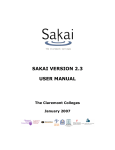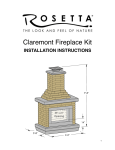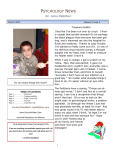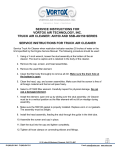Download ClaremontBio`s Lateral Flow Reagent Dispenser User Manual
Transcript
Lateral Flow Reagent Dispenser Instruction Manual LFRD v3 Rev. 03/04/2014 1182 Monte Vista Ave. Suite #11 • Claremont, CA 91786 0 Phone: 909-920-3887 • Fax: 909 -946-1132 Specifications Dimensions (L x W x H): 457 x 146 x 75 mm (excluding power supply and syringe pump) Weight: 2.45 kg Power: Adjustable to AC/DC Adapter 120 VAC: 3 – 12V Dispense Area (L x W): 302 x 64 mm LFRD v3 Rev. 03/04/2014 1 Instructions for Use 1. Plug in and turn on Lateral Flow Reagent Dispenser (LFRD) unit and external syringe pump. 2. Program syringe pump flow rate according to manufacturer’s instructions. a. See Figures 2 and 3 for recommended flow rates. b. See Appendices B and C for programming instructions for ClaremontBio’s syringe pump. 3. Select voltage on power supply. A range of 4.5 – 6V is recommended. a. If a faster head speed is desired, a power supply can connected in lieu of the provided power supply; however, 12v is the maximum voltage that can be used for the LFRD. 14 12 Head speed (cm/sec) 10 8 6 4 2 0 0 3 6 9 12 Voltage (V) Figure 1 Voltage dependence on head speed: Voltage of LFRD varied from 3 – 12v. Distance travelled = 30 cm. 4. Secure dispense tips into desired placement slot on dispense tip head using provided Allen wrench. a. For best results, position tips very close to the membrane surface, without direct contact (unless contact is desired). i. Actual height is dependent on membrane type and thickness. LFRD v3 Rev. 03/04/2014 2 b. Tips positioned too high may result in liquid droplet formation or uneven lines. c. To test positioning, place membrane on dispense table and initiate switch to cause table to move. Drag on membrane will be apparent. i. Once desired height is established, it may be helpful to mark position on metal post of dispense tip with a permanent marker. 5. Once dispense reagents have been prepared, remove air bubbles prior to use in LFRD (i.e. quick centrifugation, nitrogen air purge). a. A volume of 200 µl or greater is recommended. b. When solution is running out during dispensing, lines will appear thinner and may produce varying results. 6. Draw up each solution into a syringe, taking care to minimize air bubbles. 7. Attach tubing to blunt syringe needle and secure filled syringes on syringe pump according to manufacturer’s instructions. 8. Turn on syringe pump to prime solution(s) through tubing and dispense. Turn off pump and wipe away residual liquid. 9. Secure membrane onto LFRD dispense table using magnets. 10. Turn on syringe pump, followed immediately by dispense table switch. 11. Once dispense tips have reached the end of the table and stopped, turn off syringe pump. 12. Remove membrane from table. 13. Return dispense tips to their original position by reversing the table switch. 14. Wipe off any residual liquid from table. 15. Repeat for each membrane as necessary. LFRD v3 Rev. 03/04/2014 3 Recommended Cleaning and Storage Procedure 1. Following reagent dispensing, purge lines of remaining fluid. 2. Rinse several times with dI water. 3. Follow with several washes of 1-10% bleach (if desired). 4. Flush out bleach with dI water. 5. Purge out water and store reagent lines dry. 6. To avoid cross-contamination of reagents, it is recommended to designate one reagent dispense tip / tubing per reagent (cat # 07.811.01). LFRD v3 Rev. 03/04/2014 4 I. Appendix A Flow Rate (ml/min) A Vol./time 0.20 ml/min Vol./distance 3.24 µl/cm B 0.25 ml/min 4.05 µl/cm C 0.30 ml/min 4.85 µl/cm 0.35 ml/min 5.66 µl/cm 0.40 ml/min 6. 47 µl/cm F 0.45 ml/min 7.28 µl/cm G 0.50 ml/min 8.09 µl/cm D E Figure 2: 4.5v used for dispensing 2 mg/ml Human IgG + 5% Ethanol onto nitrocellulose with LFRD. Syringe pump flowrate varied from 0.20ml/min (A) to 0.50ml/min (G). High affinity interactions may create an intense front edge, resulting in a capture line that appears less homogeneous; therefore, a lower flow rate may be optimal (A or B), depending upon specific application. A Vol./time 0.20 ml/min Vol./distance 2.33 µl/cm B 0.25 ml/min 2.91 µl/cm C 0.30 ml/min 3.50 µl/cm D 0.35 ml/min 4.08 µl/cm E 0.40 ml/min 4.66 µl/cm F 0.45 ml/min 5.24 µl/cm G 0.50 ml/min 5.83 µl/cm Figure 3: 6v used for dispensing 2 mg/ml Human IgG + 5% Ethanol onto nitrocellulose with LFRD. Syringe pump flowrate varied from 0.20ml/min (A) to 0.50ml/min (G). High affinity interactions may create an intense front edge, resulting in a capture line that appears less homogeneous; therefore, a lower flow rate may be optimal (A or B), depending upon specific application. LFRD v3 Rev. 03/04/2014 5 Appendix B: Instructions for ClaremontBio’s Legato Syringe pump (cat. # 07.882.00, 07.882.10, or 07.882.12) 1. Turn on power at switch located in the back. 2. Programming Configuration parameters (Figure 4): a. Mode: Infuse only. Press ENTR to save. b. Syringe: Becton Dickinson Plasti-pak (press screen to select syringe size) i. Syringe size selection: 1ml. Press ENTR to save. c. Rates: xxx ml/min or xxx µl/min (determined by user). Press ENTR Figure 4. Syringe pump to save. configuration touch d. Target (optional): sets final target screen volume or time. 3. Load syringes with dispense reagent and attach tubing. 4. Place syringe in syringe holder and secure with clamp. a. If using Economy Four Syringe rack (cat. 07.883.04), snap filled syringes into place holder and secure onto pump with screw platen. 5. Put syringe pusher block flush with syringes by squeezing silver release knobs. Release to lock into place. 6. Press “Run” to start dispensing. 7. Press “Stop” when dispensing is complete to stop reagent flow. LFRD v3 Rev. 03/04/2014 6 Figure 5. Four 1cc syringes secured in syringe rack (top) and secured onto pump (bottom). Appendix C: Instructions for ClaremontBio’s Legacy Syringe pump (cat. # 07.502.01 or 07.504.01) 1. Turn on power at switch located in the back. 2. Programming parameters: a. “Select” Table. b. “Select” Bec Dic plastic. c. Arrow ( ) to 1cc 4.70 mm and press “Select”. d. Volume: 1 ml, press “Enter”. e. Rate: xxx ml/min, press “Enter”. Rate is determined by user. 3. Load syringes with dispense reagent and attach tubing. 4. Place syringe in syringe holder and secure with clamp. 5. Put syringe pusher block flush with syringes and lock by turning drive nut knob clockwise. 6. Press “Run” to start dispensing. 7. When dispensing is complete, press “run” again to stop reagent flow. LFRD v3 Rev. 03/04/2014 7
















